 Marine Nationale, 1899-1944: Gueydon, Montcalm, Dupetit-Thouars
Marine Nationale, 1899-1944: Gueydon, Montcalm, Dupetit-ThouarsWW1 French Cruisers
Sfax | Tage | Amiral Cecille | D'Iberville class | Dunois class | Foudre | Davout | Suchet | Forbin class | Troude class | Alger class | Friant class | Linois class | Descartes class | D'Assas class | D’Entrecasteaux | Protet class | Guichen | Chateaurenault | Chateaurenault | D'Estrées class | Jurien de la Graviere | Lamotte-Picquet classDupuy de Lome | Amiral Charner class | Pothuau | Jeanne d'Arc | Gueydon class | Dupleix class | Gloire class | Gambetta class | Jules Michelet | Ernest Renan | Edgar Quinet class
Design development of the Gueydon class
Following the success of the Jeanne d’Arc, the French admiralty tasked chief engineer Emile Bertin to create a simplified and cheaper version, to be built in series.
However they still were intended to fill the same commerce-raiding strategy in line with the “Jeune École” theories. With three ships built, the Gueydon class confirmed the path taken since the Jeanne d’Arc, mostly caracterized by a much greater range and better speed compared to the previous ships since Dupuy de Lôme. The last commissioned, Dupetit-Thouars, in 1905 was the only lost in WWI. The two other survived the war, the interwar, and were scuttled in 1940 in Brest, later refloated but destroyed in 1944.
A “template” with mass production
“Following” them were (they were built practically at the same time, and quicker) were the Dupleix class (Dupleix, Desaix, Kléber), the Gloire class (Gloire, Marseillaise, Sully, Amiral Aube, Condé) near-repeats of the Gueydon, and finally back to much larger ships, the Léon Gambetta class (Léon Gambetta, Jules Ferry, Victor Hugo), followed by modified one-offs, the Jules Michelet (1905) and Ernest Renan (1909). No cruiser was built by France past the launch of HMS Dreadnought. There were only unrealized projects of battlecruisers and scout cruisers before WWI broke out. In all, following the Jeanne d’Arc in 1899 and in the span of six years, the French cranked up 16 armoured cruisers for their commerce raiding war, which scenario never realized itself.
Detailed Design
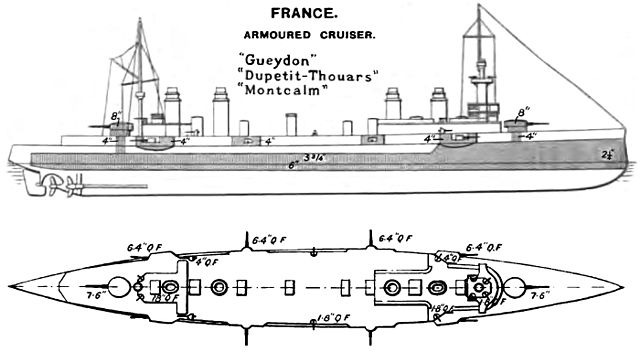
Hull and general design
 The Gueydon class measured 137.97 meters (452 ft 8 in) long overall, and with a beam of 19.38 meters (63 ft 7 in), maximum draft of 7.67 meters (25 ft 2 in) for a displacement of 9,367 metric tons (9,219 long tons). Thus they were indeed less costy to built thanks to a ten meters shorted hull (147 m/482 ft 3 in on the Jeanne D’Arc), slightly narrower of just 5 cm (2 inch), and with a lower draft.
The Gueydon class measured 137.97 meters (452 ft 8 in) long overall, and with a beam of 19.38 meters (63 ft 7 in), maximum draft of 7.67 meters (25 ft 2 in) for a displacement of 9,367 metric tons (9,219 long tons). Thus they were indeed less costy to built thanks to a ten meters shorted hull (147 m/482 ft 3 in on the Jeanne D’Arc), slightly narrower of just 5 cm (2 inch), and with a lower draft.
Protection was following about the same scheme, but less extensive by the dimensions. The Gueydon class had a lower hull, and the aft turret was not on deck, but elevated to the main upper deck.
About the silhouette, they had about the same superstructures, albeit lower and lighter, with the same, but thinner single military mast forward and pole aft like all previous cruisers, but based on a lighter machinery, with exhausts truncated into four main funnels, easier to distinguish. The hull seen from above still had a fairly elliptic design without straight section as customary of the time, hull lines were refined with narrower entries and ends. Their hull ratio was slightly less favourable, but they were regarded as better steamers overall, gaining a knot in top speed.
They had a crew of 566 officers and ratings, and would serve as flagships but added staff are not known.
Armour protection layout
It was Harvey armor for the main armor belt.
-The main belt was 150 mm (5.9 in) and extended vertically 1.3 meters (4 ft 5 in) below the waterline, and up to the upper deck over 43.0 meters (141 ft) in lenght.
-It went forward to the bow except but stopped 4.0 meters (13 ft) short of the stern.
-The lower, 150mm main armor tapered down to 91 mm (3.6 in) forward, 81 mm (3.2 in) aft, and down to 51 mm (2 in) to its lower edge.
-The upper armor strake was about 97–81 millimeters (3.8–3.2 in) down to 56–41 millimeters (2.2–1.6 in) above, between the main and upper deck.
-There was an aft transverse bulkhead, 84–41 mm (3.3–1.6 in) thick.
-There was a forward bulkhead, closing the casemate compartment, 120 mm (4.7 in) thick.
-There was another 102 mm (4 in) bulkhead below it, down to the lower deck, aft this time, rear of the casemate compartment.
-Horizontal protection comprised a main, curved, lower protective deck 2 to 2.2 inches thick. It was completed by a light armor deck on top, 20 mm (0.8 in) thick.
-Underwater protection was about the same as previous Bertin’s ships and his speciality: Extensivelty subdivided watertight internal cofferdam filled with cellulose, which ran all along these two protective decks.
-Gun turrets were semi conical with slanted sections, and had all around protection of 160–176 mm (6.3–6.9 in) with 32 mm (0.9 in) roofs.
-Main barbettes estimated 200 mm (8 in) thick, down to 50 mm (2 in) under the protective deck.
-The Main ammunition hoists had walls 2 inches thick.
-Secondary Casemate guns probably the same as for the Jeanne d’Arc, 74 mm (2.9 in) thick.
-100 mm guns had 50mm shields (2 in).
-The forward conning tower had 160 mm thick walls. There was no aft CT.
This was consistent with the previous design and perhaps better balanced, although with hindsight the thicker conning tower was not that useful. The greatest difference was the position of the aft turret, one deck higher, making for a taller barbette.
Powerplant
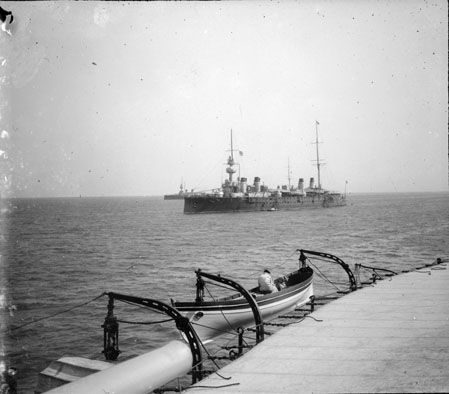 The Gueydon class like their predecessors had three shafts. The central one was the cruise shaft, and two outer ones were used for full speed. Gueydon had three vertical triple-expansion steam engines, connected to each propeller shaft. The interesting point is that not only this powerplant was reduced in size compared to the previous cruiser (which had 36 boilers and nearly 30,000 shp). Three variants were tried, all based on the same vertical triple expansion models:
The Gueydon class like their predecessors had three shafts. The central one was the cruise shaft, and two outer ones were used for full speed. Gueydon had three vertical triple-expansion steam engines, connected to each propeller shaft. The interesting point is that not only this powerplant was reduced in size compared to the previous cruiser (which had 36 boilers and nearly 30,000 shp). Three variants were tried, all based on the same vertical triple expansion models:
-Gueydon had 28 Niclausse Boilers (19.600 shp)
-Dupetit Thouars had 28 Belleville boilers (22,000 shp)
-Montaclm had 20 normand Siguaudy boilers (Unknown output, assumed to be also 22K shp)
Going up to 22,000 indicated horsepower (16,400 kW) they could reach between 21 and 22 knots (39–41 km/h; 24–25 mph), so most authors put 21.4 kts as a medium. They were reached on trials. For autonomy, the Gueydon class carried up to 1,575 metric tons of coal (1,550 long tons; 1,736 short tons), enough for 8,500 nautical miles (15,700 km; 9,800 mi) at 10 knots (19 km/h; 12 mph) which was far less than the 12,000 nm of the Jeanne d’Arc, seen probably as too ambitious. She would also travel 5,000 nautical miles at 18 knots as extrapolated from the trials.
Armament
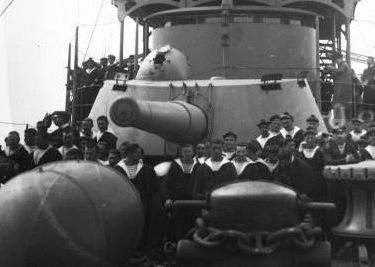
The armament of the Gueydon class was in straight line inspired by Jeanne d’Arc but with a twist: In common, they had the same single 194 mm (7.6 in) guns fore and aft, still “light” for armoured cruisers, but the secondary armament was brand new and composite: Wheras Jeanne d’Arc had fourteen single 138.6 mm (5.5 in) guns, the Gueydon class adopted eight of the new 164 mm (6.5 in) casemate guns which offered a far better range, same rate of fire, and heavier broadside. To compensate for the numbers, they had four single 100 mm (3.9 in) guns, with a much greater ROF. This made for a total of twelve guns.
The light battery was less extensive also, with ten instead of sixteen Hotchkiss 47 mm (1.9 in) guns and four single 37 mm (1.5 in) guns to compensate, located in the forward military top. This was completed by the usual torpedo tubes, the same two 450 mm (17.7 in) fixed broadside models. Overall a somewhat lighter but perhaps more balanced armament, which complicated supply though.
Main
Same two 194 mm/40 (7.6 in) guns in single gun turrets fore and aft of the superstructure as for Jeanne d’Arc and all following cruisers. It used a separate-loading, bagged charge for a 75–90 kg (165–198 lb) AP shell existing the barrel at 840–875 m/s (2,760–2,870 ft/s). ROF was 2 rpm. The mount could elevate -6° to +15°. Range was circa 12,580 yards (11,500 m).
Secondary
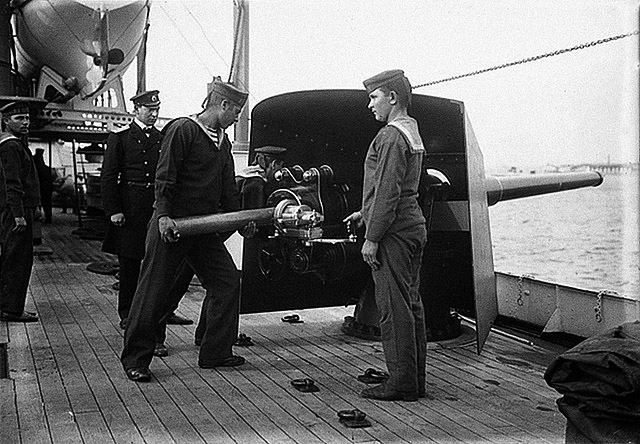
Their secondary armament comprised eight 45-caliber quick-firing (QF) 164 mm (6.5 in) guns in casemates. They were located along the hull, four in casemates to fire forward and aft, close to the bridge and aft superstructures and main turrets, and four in side postion with limited traverse.
These 164 mm guns became a staple of French designs up to that point. They were not that more powerful than the common Vickers 6-in (152mm), and the Modèle 1893 was used up to WWI and beyond, found vrtually on all cruisers and battleships of the French Navy. They had a Welin breech block, Hydro-pneumatic recoil, could elevate -10° to +25°, had a ROF of 2-3 rpm, shells leaving the barrel at 770–775 m/s (2,530–2,540 ft/s), up to 9,000 m (9,800 yd) at 25°. Later mounts allowed 36° and 18,000 m (20,000 yd).
The remainder Canet/Schneider 100mm/3.9-in guns (Canon de 100 mm Modèle 1891) fired a Fixed QF ammunition. Recoil used a Hydro-spring recuperator with a Canet screw breech for loading. ROF was 10 rpm, muzzle velocity 710–740 m/s (2,300–2,400 ft/s) and max range 9.5 km (5.9 mi). So they were even longer range compare to the 164mm.
Anti-torpedo boat armament
The same battery as before was used, but reduced. The ten Hotchkiss 47mm located along the main deck were 2 in Modèle 1886 using fixed projectiles for a 30 rpm ROF, at 571 m/s (1,870 ft/s), up to 5.9 km (3.7 mi) at +20°. The smaller 37 mm Hotchkiss (1.5 in) guns were located all four in the forward military top.
Torpedo Tubes
Same configuration as for the Jeanne d’Arc, both 450 mm tubes (17.7 in) were located above the waterline to avoid any weakness of the hull.
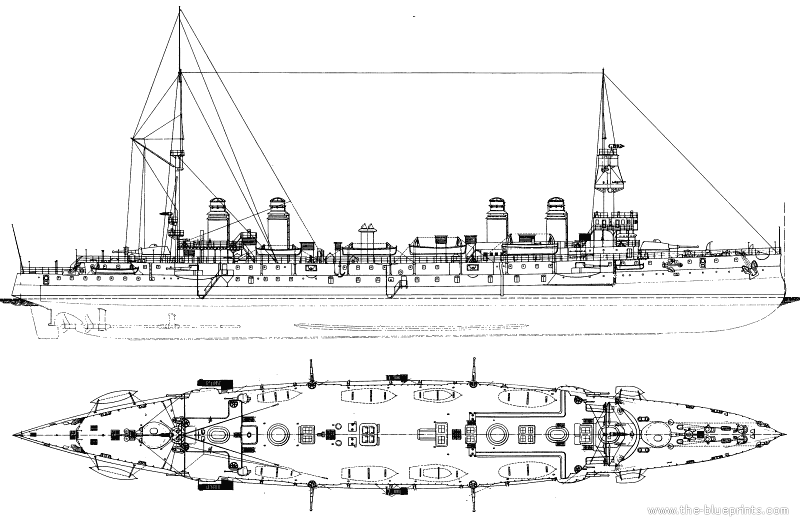 The Blueprints.com – Reconstruction of the class, two views.
The Blueprints.com – Reconstruction of the class, two views.

Illustration by the author
⚙ Gueydon class specifications as built |
|
| Displacement | 9,367 metric tons (9,219 long tons) standard |
| Dimensions | 137.97 x 19.38 x 7.67 meters (452 ft 8 in, 63 ft 7 in, 25 ft 2 in). |
| Propulsion | 3 shafts VTE steam engines, 28 Niclausse Boilers* 19,600-22.000 hp |
| Speed | 21-22 kts as designed |
| Range | 1,575 tons coal, circa 12,000 nmi at 10 knots ? |
| Armament | 2× 194, 8× 164, 4× 100, 10× 47, 4× 37, 2x 450 mm TTS |
| Protection | Main belt 6-1.6 in, turrets 8-in, casemates 4.7-in, CT 6.3-in |
| Crew | 566 |
Read More
Books
Chesneau, Roger & Kolesnik, Eugene M., eds. (1979). Conway’s All the World’s Fighting Ships 1860–1905. Greenwich: Conway Maritime Press.
Dai, Wei (September 2020). “A Discussion on French Armored Cruiser Identification: From the Gueydon Class to the Edgar Quinet Class”. Warship International. LVII (3): 199–221.
Friedman, Norman (2011). Naval Weapons of World War One: Guns, Torpedoes, Mines and ASW Weapons of All Nations: An Illustrated Directory. Barnsley, UK: Seaforth.
Jordan, John & Caresse, Philippe (2019). French Armoured Cruisers 1887–1932. Barnsley, UK: Seaforth Publishing.
Silverstone, Paul H. (1984). Directory of the World’s Capital Ships. New York: Hippocrene Books.
Sondhaus, Lawrence (2014). The Great War at Sea: A Naval History of the First World War. Cambridge: Cambridge University Press.
Commandant de Balincourt, Les Flottes de combat en 1915, Augustin Challamel
Jean-Michel Roche, Dictionnaire des bâtiments de la flotte de guerre française de Colbert à nos jours, t. 2, Rezotel-Maury Millau, 2005
Jean Meyer et Martine Acerra, Histoire de la marine française : des origines à nos jours, Rennes, Ouest-France, 1994, 427 p.
Michel Vergé-Franceschi (dir.), Dictionnaire d’Histoire maritime, Paris, éditions Robert Laffont, coll. « Bouquins », 2002, 1508 p.
Alain Boulaire, La Marine française : De la Royale de Richelieu aux missions d’aujourd’hui, Quimper, éditions Palantines, 2011
Rémi Monaque, Une histoire de la marine de guerre française, Paris, éditions Perrin, 2016, 526 p.
Les Flottes de Combat en 1917, Commandant de Balincourt, Augustin Challamel, 1917
Les marques particulières des navires de guerre français 1900-1950, Jean Guiglini, SHM, 2002
Les navires français 1914-1918, Jean Moulin, Marines Editions, 2008
Dictionnaire des bâtiments de la flotte de guerre française de Colbert à nos jours, Tome II, 1870-2006, LV Jean-Michel Roche, Imp. Rezotel-Maury Millau, 2005
Répertoire des navires de guerre français, Jacques Vichot, Pierre Boucheix, refondu par Hubert Michéa, AAMM, 2003
Links
https://www.battleships-cruisers.co.uk/gueydon_class.htm
http://www.netmarine.net/dico/index.htm
https://en.wikipedia.org/wiki/Canon_de_100_mm_Mod%C3%A8le_1891
http://navypedia.org/ships/france/fr_cr_gueydon.htm
https://en.wikipedia.org/wiki/Gueydon-class_cruiser
https://fr.wikipedia.org/wiki/Classe_Gueydon
http://www.navweaps.com/Weapons/WNFR_39-45_m1892.php
 FS Gueydon (1899)
FS Gueydon (1899)
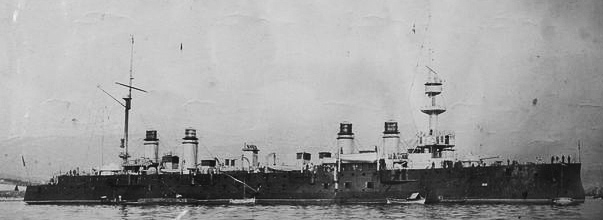
The first cruiser was named after Louis Henri de Guédon, Briton Vice Admiral, Governor of Brest and first governor of Algeria under the Third Republic. She was built at Arsenal de Lorient, started on 2.8.1898, launched on 20.9.1899 and completed, commissioned on the first September 1903 (construction time six years).
Gueydon was armed in Toulon in 1903 and started her first campaign in the Far East, based in Indochina for a time. Its assignation there ran from 1903 to 1906 after which, and following a refit, she was in gome waters (Toulon) in 1906-1909, then in service along the South Atlantic in 1910-1915.
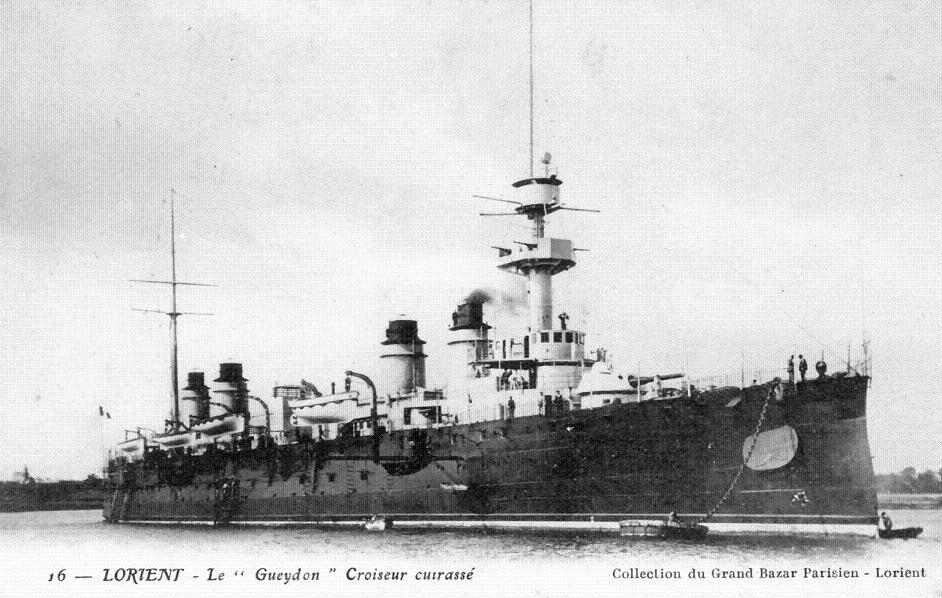
When WWI started, she patrolled and escorted convoys along the shores of South America, from Brest to Gribraltar in 1915, and to the West Indies (French Caribbean, Antilles) in 1916. It seems this was her assignation until 1918, without much action. In 1919 she was in limited service and probably in reserve in 1922 due to to the Washington treaty limitations.
In 1923, she was comprehensively overhauled at Arsenal in Brest to serve from 1926 in Toulon as a gunnery schoolship. She had part of ther machinery removed (aft boilers groups) to make room for extra accomodation and had a mix of weapons to present the trainees all types in service. In 1927, she replaced Pothuau (an old protected cruiser) in this role. She was stricken in 1935, and from there was reconverted as a pontoon-barracks for the Preparatory School of the Navy.
She was anchored in Brest when WW2 started. She was notably photographed by the Luftwaffe, and to avoid capture, scuttled on June 18, 1940, just before troops entered the city. However her hull sunk in shallow waters and still emerged. She was refloated by the Germans but found little use, until at least she was maskeraded in 1943 as the cruiser Prinz Eugen to deceive RAF observers. The Germans added the old sloops Aisne and Oise to beef it up, erecting fake superstructures. Eventually she was completely blasted by the Germans in August 1944, during the capture of Brest by the allies, Free French and resistance groups. Photo 1 Photo 2
 FS Montcalm (1900)
FS Montcalm (1900)
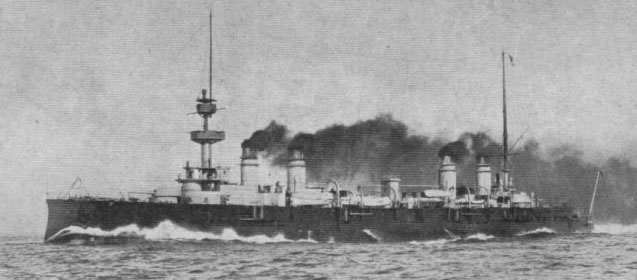
FS Montcalm, named after the French General in North America, was built in F C de la Méditerranée, La Seyne, south of France. Laid down on 27.9.1898 she was launched on 27.3.1900 and completed on 24.3.1902 (five years construction).
After sea trials and working out, she made her maiden voyage and shakedown cruise by conveying French President Émile Loubet to Russia, reaching Kronstadt in the black sea, to receive the official visit of Tsar Nicolas II on board for lunch on May 23, 1902. From 07.02.1903 she departed for the far east fleet, and served there until 1906. In 1906, she lost a propeller while steamiong back home in the Mediterranean. She was repaired in Bizerte and returned to Brest for final repairs and overhaul. She returned to the Far East fleet, until 1910, and was back home to be used on the south atlantic until the war broke out.
On February 17, 1915, the British requested her for a mission to Singapore, to quell a rebellion by companies of the 5th Light Infantry Regiment of the Indian Army. The latter was fuelled by the party’s anti-British nationalist propaganda “Ghadar”. The same year she returned to her patrol duties along the Atlantic coast from Brest to Gibraltar. The next year in 1916 like her sister she covered convoys to the Caribbean and South America, until 1918.
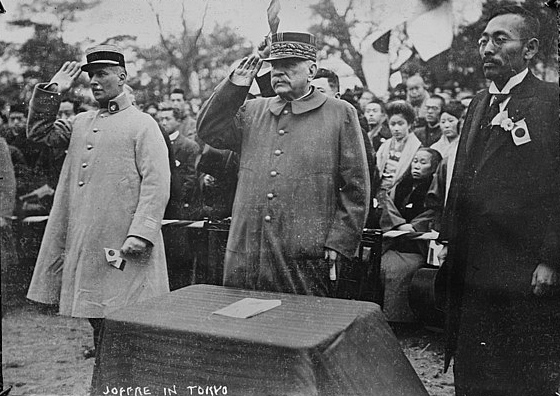
Marshall Joffre in Tokyo, as part of a goodwill diplomatic trour on behalf of the French government in Asia.
In 1921, she left for Singapore again, as part of Joffre’s Mission in the Far East. She carried the Marshal for a “goodwill tour” of four months in Asia. This tour lasted from November 11, 1921 – to March 12, 1922, a diplomatic mission to strengthen French influence in emerging Asian countries such as Indochina, Cambodia, Siam, Japan, Korea and the China, also to thank them, in his name as commander in chief, for their participation in the Great War.
Montcalm was decommissioned on October 28, 1926 and was converted as a training ship, paer of the “Armorique Group”, renamed “Trémintin” to free the name for a French heavy cruiser, in 1934. When the Second World War broke out, she was in Brest, scuttled on June 18, 1940 as German troops entered the city. She was refloated but destroyed again in 1943 following an air raid. Other sources states August 1944 which was more likely.
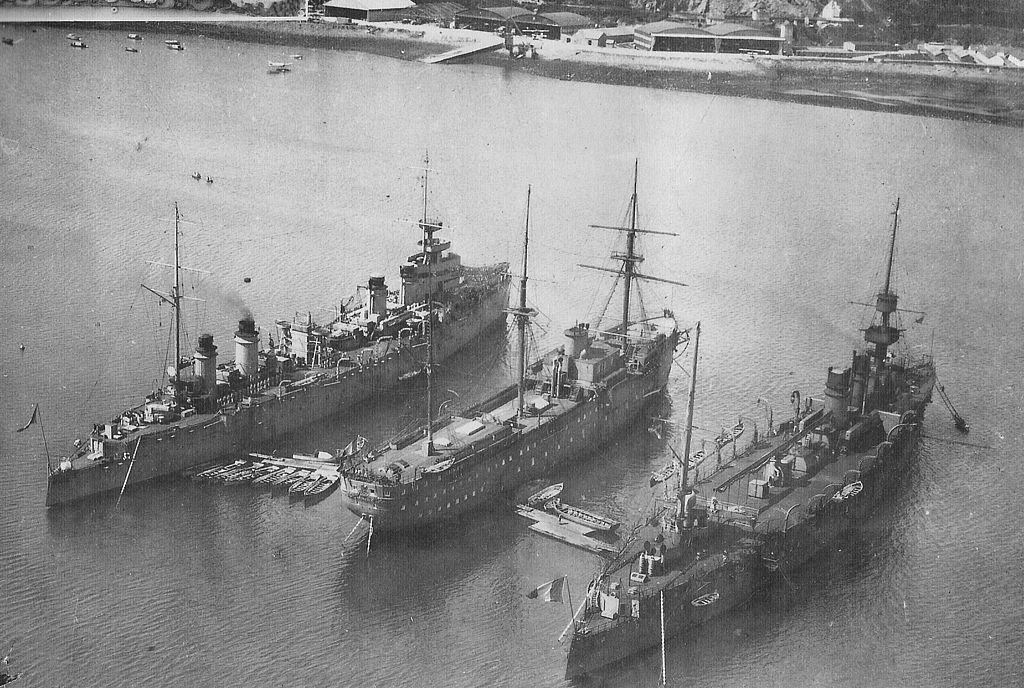
“Armorique” school group, with Tremintin (ex-Montaclm) and Gueydon, modified as a school ship. Photo reconnaissance by the Luftwaffe over Brest in June 1940.
 FS Dupetit-Thouars (1901)
FS Dupetit-Thouars (1901)
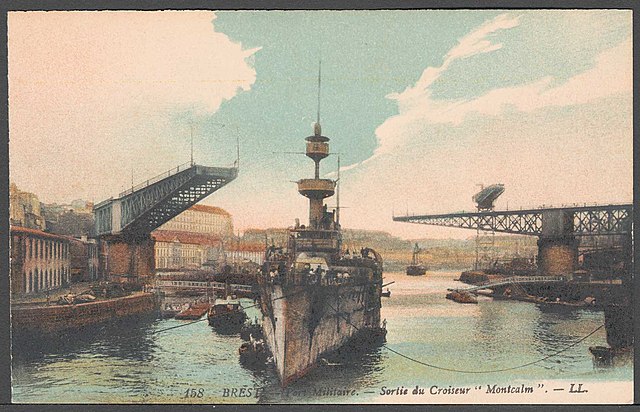
The cruiser, built at Toulon was named after Aristide Aubert du Petit-Thouars (1760-1798), killed in Aboukir while commanding Le Tonnant. She was laid down on 17 april 1899, launched on 5 july 1901 and completed on 28 august 1905 (6 years). She served at first in the Mediterranean, with nothing really notable but her peacetime exercises and upkeep periods routine. After a reserve period from 1911 to 1913, the Dupetit-Thouars was assigned in 1914 to the ocean instruction division. The cruiser will then carry out various missions during this period of war, including the escort of supply convoys leaving from North America to France.
In WWI she served in various escort missions and patrols between the far east, Mediterranean and Atlantic. In 1918 she mostly carried out transtlantic escorts. It’s with one of these, in August, that she was sunk by U-62.
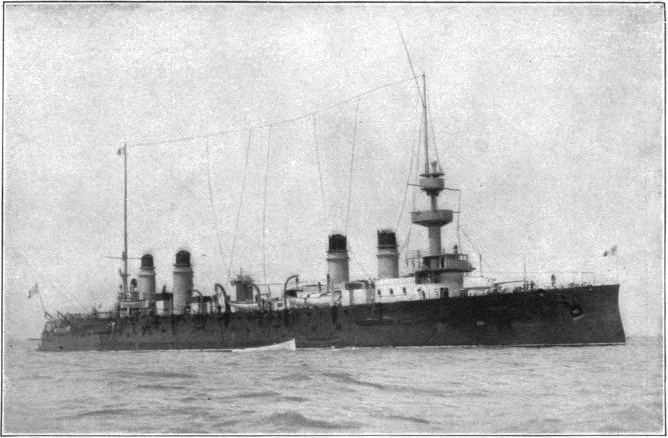
Montcalm in the naval review EB1911
The sinking: Commander Pasqué commanded the ship on 26 June, sailing from New York to take charge of a convoy of 24 merchant ships leaving Halifax for the Verdon in France. On August 7, 1918, 7:50 p.m., carrying out a security mission in the Atlantic, 800 km from the French coast, for the Cruiser and Transport Force. She was ambushed (as known later) by SM U-62 at 46° 18′ north latitude, 12° west longitude. Armand Baudoin organized the evacuation aboard makeshift rafts, saving almost all of the crew. Out of 500 men, only ten were lost. Those still stranded at sea had to wait until August 8, spotted and picked up by USS Tucker, later landedin Brest on August 12. Commander Armand Baudoin was made a Knight of the Legion of Honor on August 15, 1918 by President Poincaré for his actions to save his crew.
As per the report when it arrived the Commander Pasqué went out for dinner while on the bridge was second in command, Captain of the Corvette Winter. Since she was underway in a very dangerous sector, all lookoputs were at their post, officers in duty on deck and engines as the crew. The outside watch from the forward topmast would warn the bridge at any moment by megaphones and by an electric warning bell. There was a security service in combat posts in case.
The was electrical emergency lighting was provided, reduced lights activated, maneuvering winches constantly heated and lifeboats arranged outside under the davits, whaleboats and yawl stored on the bridge. There were also many inflatable rafts and all men on the upper decks wore their lifejackets or have them close at hand. In addition the captain frequently ordered evacuation drills the day before each departure.
The three wireless telegraphy stations and radio direction-finding station were constantly armed. Ship position was reported by radio every half hour from the main and emergency station.
As the sun set at 8:15 p.m. the convoy stopped zigzagging, assuming a too low visibility for effective submarine operations. FS DUPETIT-THOUARS however leading the front of the convoy was still lacing at that time and by 8:45 p.m., moved circa 1000 meters in front of the convoy’s center.
The horizon was still clear enough to see the ships’s silhouettes. However wothout warning the first torpeo hit at 8:51 p.m. on the starboard side, under the forward bridge. Ten seconds later, a second hit near the aft gangway. No one spotted either the submarine or its periscope also Lt. POCHARD on the main lookout post, saw the last element of the trajectory first torpedo wake.
The damage was immediately apparent as the ship took a moderate list to starboard, and seemed slow enough to take measures. Security teams tried to stop the flood, but the explosion served the electric circuitry, most lamps shut inside the machinery and total darkness after the second hit due to the rupture of the lead switchboard.
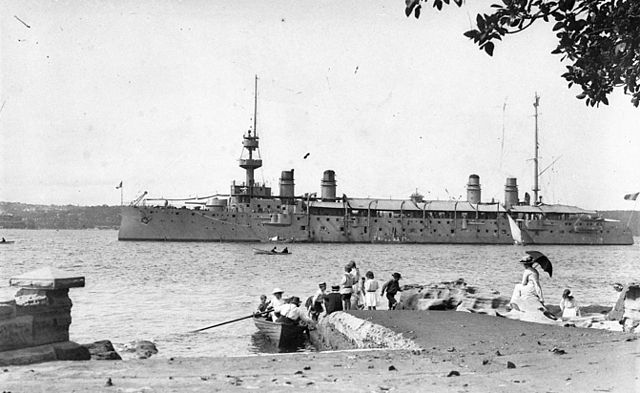
Montcalm in Sydney, 1914, photo by Sam Hood
A few emergency quinquets allowed minimal visibility in the engines and boiler room and officers carried American portable electric lamps.
On the bridge, the hit broke the windows, damaged various control and transmission systems and acoustic pipes which prevented steering and communication with the engines. The megaphone was used instead. The wireless mast came down and a lifeboat was swept away.
A distress signal was posted though, and if the main machinery still worked, auxiliary machines died, and the pumps with them. Officers reported that even the progression of the flood was slow, there there was no chance of saving the ship and now only personnel safety mattered. Captain Winter ordered “full port, 90 turns” to move away from the probable position of the submarine, but all links with the steering room were broken, as well as to the port engine. Commander Pasqué back on bridge ordered to move on the port side to not coming across the convoy, risking collisions.
Aftr being informed of the extent of the flooding and damage, he ordered Captain Winter to start the evacuation on deck. He ordered to stop the engines, to lower the flooding but the list progressed. The evacuation was very orderly, going on for nearly sixteen minutes, in boats and rafts, others being picked up by escorting US destroyers.
The cruiser sank just moments after the last men and two commanders left the board. Documents contained in the box of the cipher room were thrown at sea. Of the ones lost, three died in boiler room 3, and the remaining ten were probably dragged with their rafts, into the capsizing. Officers indeed toured the ships in the depht to be sure none was missing. 50 minutes after the torpedoing, Dupetit Thouars went down. On August 8, all six escorting US destroyers Tucker, Drayton, Winslow, Porter, Warrington and Fanning carried the survivors. However around 10 p.m., the guilty U-62 emerged near the remaining rafts, maneuvered with precaution, alongside one of them and and officer spoke in French to ask the name, tonnage of the cruiser sunk, sent food and clothese, took off one of the men’s cap for its ribbon as souvenir and disappeared. U-63 was an U-57 class U-Boat, very successful as between 1917 and 1918 she sank 53 ships, Dupetit-Thouars included, her last and best “kill” of this war.

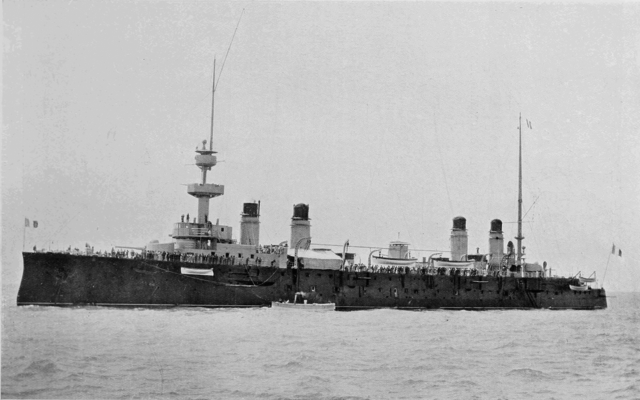
 Latest Facebook Entry -
Latest Facebook Entry -  X(Tweeter) Naval Encyclopedia's deck archive
X(Tweeter) Naval Encyclopedia's deck archive Instagram (@navalencyc)
Instagram (@navalencyc)





 French Navy
French Navy Royal Navy
Royal Navy Russian Navy
Russian Navy Armada Espanola
Armada Espanola Austrian Navy
Austrian Navy K.u.K. Kriegsmarine
K.u.K. Kriegsmarine Dansk Marine
Dansk Marine Nautiko Hellenon
Nautiko Hellenon Koninklije Marine 1870
Koninklije Marine 1870 Marinha do Brasil
Marinha do Brasil Osmanlı Donanması
Osmanlı Donanması Marina Do Peru
Marina Do Peru Marinha do Portugal
Marinha do Portugal Regia Marina 1870
Regia Marina 1870 Nihhon Kaigun 1870
Nihhon Kaigun 1870 Preußische Marine 1870
Preußische Marine 1870 Russkiy Flot 1870
Russkiy Flot 1870 Svenska marinen
Svenska marinen Søværnet
Søværnet Union Navy
Union Navy Confederate Navy
Confederate Navy Armada de Argentina
Armada de Argentina Imperial Chinese Navy
Imperial Chinese Navy Marinha do Portugal
Marinha do Portugal Mexico
Mexico Kaiserliche Marine
Kaiserliche Marine 1898 US Navy
1898 US Navy Sovietskiy Flot
Sovietskiy Flot Royal Canadian Navy
Royal Canadian Navy Royal Australian Navy
Royal Australian Navy RNZN Fleet
RNZN Fleet Chinese Navy 1937
Chinese Navy 1937 Kriegsmarine
Kriegsmarine Chilean Navy
Chilean Navy Danish Navy
Danish Navy Finnish Navy
Finnish Navy Hellenic Navy
Hellenic Navy Polish Navy
Polish Navy Romanian Navy
Romanian Navy Turkish Navy
Turkish Navy Royal Yugoslav Navy
Royal Yugoslav Navy Royal Thai Navy
Royal Thai Navy Minor Navies
Minor Navies Albania
Albania Austria
Austria Belgium
Belgium Columbia
Columbia Costa Rica
Costa Rica Cuba
Cuba Czechoslovakia
Czechoslovakia Dominican Republic
Dominican Republic Haiti
Haiti Hungary
Hungary Honduras
Honduras Estonia
Estonia Iceland
Iceland Eire
Eire Equador
Equador Iran
Iran Iraq
Iraq Latvia
Latvia Liberia
Liberia Lithuania
Lithuania Mandchukuo
Mandchukuo Morocco
Morocco Nicaragua
Nicaragua Persia
Persia San Salvador
San Salvador Sarawak
Sarawak Uruguay
Uruguay Venezuela
Venezuela Zanzibar
Zanzibar Warsaw Pact Navies
Warsaw Pact Navies Bulgaria
Bulgaria Hungary
Hungary

 Bundesmarine
Bundesmarine Dutch Navy
Dutch Navy Hellenic Navy
Hellenic Navy Marina Militare
Marina Militare Yugoslav Navy
Yugoslav Navy Chinese Navy
Chinese Navy Indian Navy
Indian Navy Indonesian Navy
Indonesian Navy JMSDF
JMSDF North Korean Navy
North Korean Navy Pakistani Navy
Pakistani Navy Philippines Navy
Philippines Navy ROKN
ROKN Rep. of Singapore Navy
Rep. of Singapore Navy Taiwanese Navy
Taiwanese Navy IDF Navy
IDF Navy Saudi Navy
Saudi Navy Royal New Zealand Navy
Royal New Zealand Navy Egyptian Navy
Egyptian Navy South African Navy
South African Navy






























 Ukrainian Navy
Ukrainian Navy dbodesign
dbodesign